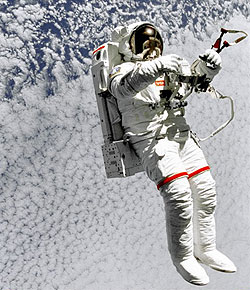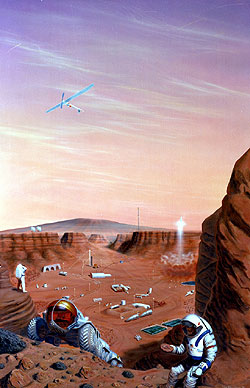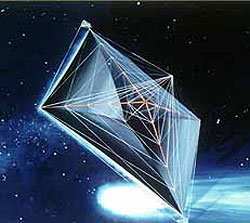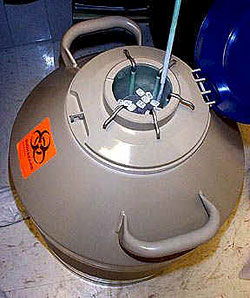| The
furthest we have been is the Moon. If we want to travel into deep
space, beyond our own backyard, the Solar System, we'll need a new
breed of spacecraft.
by Stuart Carter
It may be the oldest cliché in town, but in the not too distant
future science fiction will turn into science fact. The fantastic
spaceships of sci-fi comic books and novels will no longer be a
figment of our creative imagination; they may be the real vision
of our future.
Engineers and designers are already designing craft capable of
propelling us beyond Earth's orbit, the Moon and the planets. They're
designing interstellar spaceships capable of travel across the vast
emptiness of deep space to distant stars and new planets in our
unending quest to conquer and discover. Our Universe contains over
a billion galaxies; star cities each with a hundred billion inhabitants.
Around these stars must exist planets and perhaps life. The temptation
to explore these new realms is too great.
First things first - we'll have to build either a giant orbiting
launch platform, far bigger than the International Space Station
(ISS), or a permanently manned lunar base to provide a springboard
for the stars. Some planners feel we should limit ourselves to robotic
probes, but others are firmly committed to sending humans. "There's
a debate right now about how to explore space" says astronaut Bill
Shepherd, destined to be the first live-aboard Commander of the
ISS. "Humans or machines - I think they're complementary".

NASA
The
effects of weightlessness may be too much to bear on long
missions
|
The human problem
Space is the most hostile environment we will ever explore. Even
a single five-hour spacewalk requires months of training, and a
vast technical backup to keep it safe. The astronauts and cosmonauts
who live aboard the ISS will be there for only a few weeks or months;
if we want to travel into deep space it could take years. First
we'll have to find out just how long the human body can survive
in a weightless environment. In zero gravity, four pints of body
fluid rush from the legs to the head where it stays for the duration
of the mission. Astronauts often feel as if they have a permanent
cold, and disorientation can become a major problem. In space there's
no physical sensation to let you know when you're upside down and
astronauts have to rely on visual clues from their surroundings.
A few hours after reaching orbit, one in three of all astronauts
will experience space sickness - a feeling rather like carsickness.
And weightless conditions lead to calcium being leached from the
bones, and problems with the astronauts' immune systems.
Trillions of rocky fragments - meteoroids - roam our Solar System
at speeds of up to 150,000 miles an hour. A meteoroid no bigger
than a grain of salt could pierce a spaceship window. Protection
from the extreme hazards of space is going to need some clever technology.
Space is also full of lethal radiation - X-rays, gamma rays and
the high-speed particles called cosmic rays.
Down here on Earth we are protected by the atmosphere and by our
planet's magnetic field, but in space long haul astronauts suffer
gradual but irreversible radiation sickness unless they are carefully
shielded. Commander Shepherd is confident the ISS will help us crack
the problems "The ISS is going to answer a number of questions about
long range exploration in space. A lot of things are going to be
pioneered on the space station for future exploration".

NASA
The
slingshot concept could propel us into deep space
|
Stepping stones
Saturn V is still the most powerful rocket ever built. But even
this vast 3000 tonne giant carried only enough fuel to send a tiny
manned capsule with just three men on a 250,000 mile journey - a
mere drop in the cosmic ocean. It's over a quarter of a century
since the last man stood on the Moon (Commander Gene Cernan on the
Apollo 17 mission in 1972), and it seems that it will be another
quarter of a century before we return to build a permanently manned
base there. Bob Forward - who earns his living from designing spaceships
of the future - believes we'll have to find a cheap way of reaching
the Moon before we think of living there. His slingshot concept
may seem radical at the start of the 21st century, but it is certainly
ingenious. "If you have something rotating quite fast around another
thing on the end of a string, it has a tendency to fly away. You
have to decide when to let go (from Earth-orbit) and - like a trapeze
artist catching his partner - you have to decide when to catch the
payload (in lunar orbit)". A lunar base would become a viable stepping
stone to deep space. In the 1990s, the Clementine and Lunar Prospector
spacecraft detected frozen water below the lunar surface. This could
be mined, melted and broken down to make liquid oxygen and hydrogen
rocket fuel needed to blast off into deep space.

NASA
Life
on Mars will be the ultimate test for humans
|
But before we leave the Solar System on our interstellar quest
we will have to conquer it. Mars will become our first target. Whether
we'll reach it directly from Earth, from Earth's orbit or from the
Moon is anyone's guess but Mars is far from being a barren desert
like the Moon.
Mars probably has plentiful supplies of frozen water below the
surface and even has 24-hour days! Unfortunately the atmosphere
is 95% carbon dioxide, with just a fraction of the Earth's atmospheric
pressure and no protective ultraviolet layer. Martian astronauts
will have to live in sealed modules, and wear spacesuits to venture
outside. Mars would be a tiny colony, like the remote outposts of
the early Earth explorers. Mars itself will probably never be a
stepping stone to the stars, but it will help us learn if we can
live in such a remote and harsh place for years or even a lifetime.
The round trip to Mars will take at least two years - on the most
fuel-economical route, the travel time alone will be 9 months each
way. So we either have to find much faster propulsion system or
ways of helping the human body to cope.
It's only rocket science
Scientists are already experimenting with propulsion systems that
may travel much faster than today's conventional chemical rockets.
Franklin Chang's plasma rocket may be the answer. "In a plasma rocket
you're continually accelerating," he explains.

NASA
The
plasma rocket may reduce the journey to Mars from nine months
to three months
|
A trip to Mars could be cut to 90 days, claims Chang. His rocket
harnesses a nuclear process to produce a hot gas plasma. The plasma
is magnetically held in a rocket the shape of a bottle and then
expelled at very high velocity to provide propulsion. The plasma
has to be heated to millions of degrees. Chang believes his system
will be too good just to reach Mars. "I think it will quickly be
developed for interplanetary travel within our Solar System". The
plasma rocket is now under development at NASA's Houston laboratories.
Another new method of propulsion is already flying through our
Solar System. Pushed only by an electronically driven 'ion engine',
Deep Space One is already over 100 million miles from Earth. It
works by ionising xenon gas and expelling it with the aid of electric
fields, so providing a gentle but constant thrust. The ion engine
provides a force about the same as a single sheet of paper exerts
on your hand - far too weak to lift a spacecraft from the surface
of a planet - but the continuous acceleration has already pushed
Deep Space One to a speed ten times higher than any of the manned
rockets we use today.

NASA
The
solar sail could reach speeds one tenth the speed of light
|
Interstellar travel
To leave the Solar System and carry humans to the stars we will
have to find a way of travelling near to the speed of light. Even
then a journey could take hundreds or thousands of years. Travelling
at 1/10 the speed of light it would take over forty years to reach
the nearest star, Alpha Centauri.
One giant source of free energy is our Sun. Bob Forward has designed
the solar sail, a craft that doesn't have to carry its own fuel
supply. It's driven by the power of the Sun's rays, and it will
be the fastest machine ever built. "The sunlight bounces off the
aluminium sails and in the process gives it a tiny push," explains
Forward. Like the ion probe it will accelerate and accelerate. And
it's not a total dream. NASA is already experimenting with deploying
large sails in Earth-orbit. Propelled by light, solar sails will
travel thousands of times faster than Apollo or the Shuttle.
Asleep or awake?
Even with the perfect spaceship it isn't going to be easy. In his
classic sci-fi novel 2001, Arthur C. Clarke used the concept of
suspended animation as a way for humans to cope with long space
flights. He imagined that we would be able to put the human body
into hibernation - suspended animation - to escape the boredom of
long interstellar missions.

Advanced
Fertility Center
Capsules
would store frozen embryos or people in suspended animation
|
An even more drastic measure might be to freeze the astronauts.
We already use cryogenic techniques to preserve dead bodies and
store human embryos. Freezing living adults may not be so far away,
but perhaps we won't have to do that. Perhaps we should use our
existing technology and send frozen embryos across to the far corners
of the cosmos.
It could certainly save on space. Then hundreds of years from now,
billions and billions of miles away, the embryos will be thawed
and their hearts will start beating. These space-farers of the future
will not grow inside a mother's body but will be incubated in a
machine. They will be brought up by robot. It may seem strange and
radical but one day it might just happen…
"Who's to say in 25 years what we'll be doing in space? I think
all estimates may be wildly short of the mark," muses Commander
Shepherd.
Copyright (c) FirstScience.com
|
